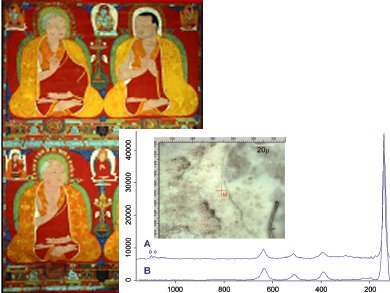Richard R. Ernst, Nobel Laureate in Chemistry and grandson of Walter Ernst, developed accidentally during a tourist journey through Asia, and particularly Nepal, a fascination for Tibetan Buddhist art. Together with his wife, he established a sizeable collection of paintings from the 12th to the 19th century.
In the course of maintaining his precious collection, Richard Ernst started to realize that art conservation is one of the most demanding scientific occupations conceivable. After his compulsory professional retirement, he converted a hobby crafting room within his private home into a tiny specialized analytical spectroscopy and restoration lab.
He found that not all kinds of spectroscopy are applicable for non-invasively examining painting art. For example, Ernst’s beloved NMR spectroscopy is often unsuited because paintings are too bulky for fitting into a narrow-gap NMR spectrometer. Also NMR techniques are frequently not sensitive enough for examining the thin layers of pigments applied by the artist.
The most ideal analytical technique for pigment studies is Raman spectroscopy. It is non-destructive, if used with some care not to burn holes into the canvas by excessive laser power. It is truly a molecular analysis technique, measuring indirectly the vibration frequencies of molecules or crystalline material. And it can be implemented on a relatively small space, like in a tiny analytical laboratory.
Raman spectroscopy allowed Richard Ernst to identify that the eyes of the monks in one very special 13th century picture of his have been restored in the 20th century with a special pigment. No traces of further restorations have been found.
- A Chemist Remains a Chemist,
Richard R. Ernst,
Angew. Chem. Int. Ed. 2013, 52, 61–67.
DOI: 10.1002/anie.201205461
Angewandte Chemie International Edition celebrates its 125th anniversary this year.
As part of the celebrations, the first issue is a special jubilee issue and an Angewandte Chemie Symposium will be held in Berlin and broadcasted via ChemistryViews.org on Tuesday, March 12, 2013.




